From shelf to digitisation — Preserving our audiovisual heritage
To celebrate the upcoming World Day for Audiovisual Heritage 2023, read about our audiovisual digitisation project “Utaina”, and watch our video of the Utaina digitisation process.
A year since we started
The Utaina project is now in full swing, digitising audiovisual material from the National Library and Archives New Zealand collections as well as from Ngā Taonga Sound & Vision.
In October 2022, we sent our first shipment of collection items to our digitisation partner Memnon based in Motutawa Avalon, Lower Hutt. A year on, three formats — one-inch video, two-inch video and Betacam — have completed digitisation, while the next four — vinyl, audiocassettes, VHS and sepmag — are in full production. By early next year, we will begin digitising shellac, lacquer, and open reel audio tapes.
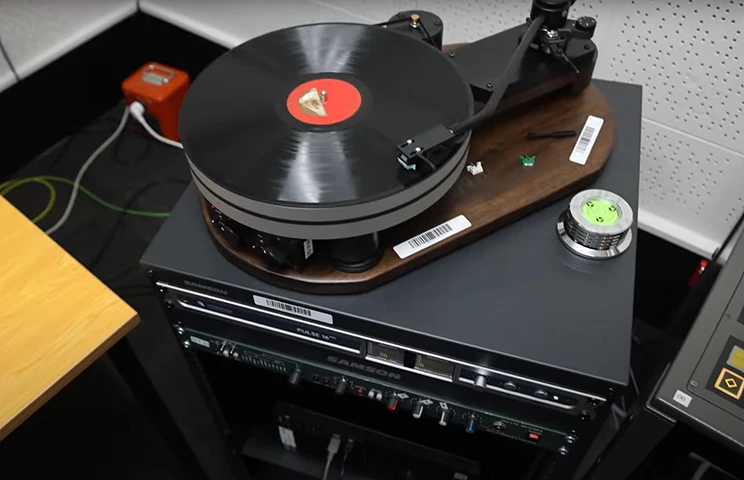
A vinyl record of Race Game (Ref: Phono q 4564) during the digitisation process. Screenshot from Utaina video.
Watch a video about the Utaina digitisation process
Transcript — Utaina! — audiovisual digital preservation project
Speakers
Jessica Moran, Associate Chief Librarian, National Library, Lousie McCrone, Directory Holdings and Discovery, Archives NZ
On-screen: Utaina! ‘Load the precious freight on board!’
Jessica Moran: Utaina is a multi-year, audio visual digitisation project. Our aim is to preserve the Crown's AV collections across our three organisations, National Library, Archives New Zealand and Ngā Taonga Sound & Vision.
On-screen: Which items are being digitised?
Jessica Moran: For us, the National Library's collections include material from the Archive of New Zealand Music, and the Oral History and Sound Archive.
Lousie McCrone: Archives New Zealand's holdings include everything from government publicity and advertising through to evidential recordings from the Police and Ministry of Justice.
On-screen: What are the challenges?
Jessica Moran: Because our collections are not broadcast they range many formats and in various conditions. So it's essential for this really rare and important recorded history that we digitise it now before it's too late.
On-screen: How long will this take?
Jessica Moran: We're really fortunate that we've been able to partner with Memnon, who are an internationally recognised specialist in preserving AV material.
With their expertise, their specialist equipment, and their experience doing projects at this scale working collaboratively we'll be able to preserve our collections over the next few years. Something that we estimated if we had tried to do on our own, would take us at least 100 years.
Lousie McCrone: We know that we couldn't do this work by ourselves. And we are really excited to share the digitisation journey of some of the taonga that's part of our holdings with you in this video.
On-screen: Welcome to the digitisation process
Batches are selected for digitisation each week in advance. These batches are selected by format.
Supporting material is removed and stored.
The items are carefully recorded and packaged.
The experienced team from Crown FIL collect the pallets. The items are carefully transported to the digitisation factory at Avalon Studios.
The items are passed into the care of Memnon, our digitisation partner. At Memnon — many formats are checked in and may go through a preparation process.
Then each item is recorded individually in real time.
[Music plays]
A wide variety of formats including 1-inch video tapes are digitised.
Each digital file goes through several quality checks.
The QC team also manually check a selection of digital files.
Audio from digitised file of Helen Clark, previous Prime Minister of NZ: “I think there is a glass ceiling just above where I am, which is very hard to crack.”
On-screen: The FIL team collect the pallets and return them to National Library and Archives.
Returned items are checked back into the catalogue reunited with supporting material and returned to their shelves.
When QC is passed – the digital file transfers to the Library and Archives’ Digital Preservation System.
Audio from digitised file: Horse racing commentary from a digitised item called "The Race Game"
Digitised items are now available on request through the digital catalogue.
NZ road safety advertisement featuring Dave Dobbyn, 1985
Audio from digitised file: ‘Only a dummy doesn't belt up.’
On-screen: Utaina will digitise around 100,000 audiovisual items from Archives and National Library.
It is the largest AV digitisation project of its kind currently across the globe.
Utaina – Audiovisual Digital Preservation Project National Library of New Zealand –natlib.govt.nz
Archives New Zealand – archives.govt.nz/about-us/our-work/utaina
Ngā Taonga Sound & Vision – ngataonga.org.nz
World Day for Audiovisual Heritage
The publication of this video coincides with the upcoming World Day for Audiovisual Heritage 2023 on 27 October. This commemorative day celebrates the priceless heritage captured by audiovisual archives and raises awareness of the need to take urgent measures to acknowledge and preserve our audiovisual histories. Read more about it on the UNESCO website.
Care and safe handling of collections
Ensuring the safety of our collection items is critical. Detailed planning goes into the logistics and tracking of each item, as well as their physical protection during transport and digitisation. We carefully package each item that is sent to Memnon for digitisation. This involves packing items within transport crates with foam wrapping to make sure they will not be damaged by any jolts or bumps during their journey.
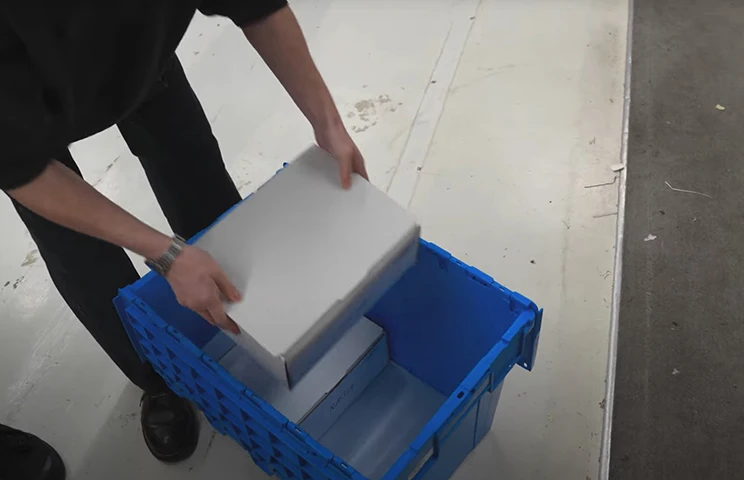
Items being packed ready for their digitisation journey. Screenshot from Utaina video.
Before sending, all items are scanned into the project’s tracking tool and have their locations updated on the relevant catalogues. The video shows staff members scanning each item into their relevant transport box. The transport box is then assigned to the pallet and the pallet to the shipment. This detailed tracking means that we record the exact location of each item and create a history of each item’s movements.
Ensure long-term preservation of collections
Care and long-term preservation of the collection items have been central to the planning of the project. A key step that highlighted this importance in the video is the removal of supporting materials. These are additional materials that are part of the item, and can be promotional posters, booklets, or loose notes from the time of recording but aren’t required for digitisation.
Our team carefully separate these supporting materials from our audiovisual items before they are transported to reduce the risk of disassociation. Disassociation is one of the ten agents of deterioration that can affect heritage items. It can occur when parts of an item become separated or the links between them are lost.
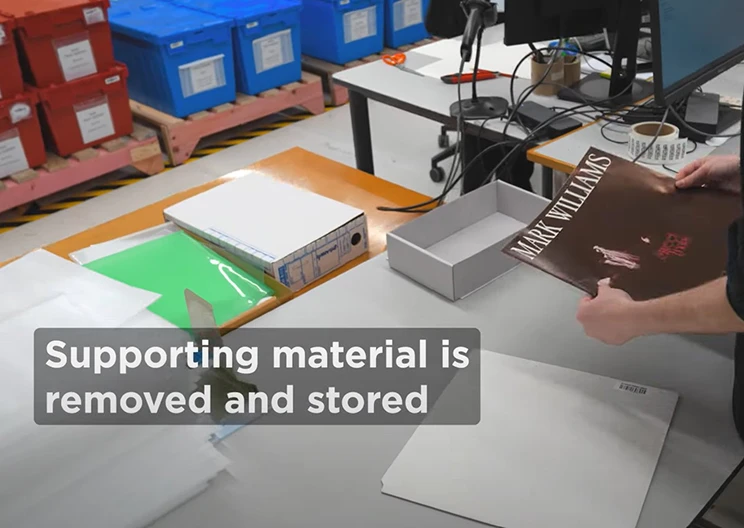
Supporting material being removed and stored. Screenshot from Utaina video.
Because these supporting materials, such as loose sheaves of notes, may be easily parted or misplaced during the process of transit and digitisation, we temporarily separate these materials to avoid this potential for loss.
During digitisation the supporting material is kept onsite at the National Library or Archives New Zealand, clearly labelled and stored until the item is returned. Upon return, our team reunite the supporting materials with the corresponding audiovisual item and both can be reshelved back to their permanent location.
Quality control
After digitisation, our Quality Control (QC) Technicians assess the digitised files to ensure they are an accurate copy of the physical items. Often our technicians will closely listen to and view these digitised items to identify anything that does not appear to be inherent to the original item. They will listen for things like muffled audio, video dropouts, and distortion.
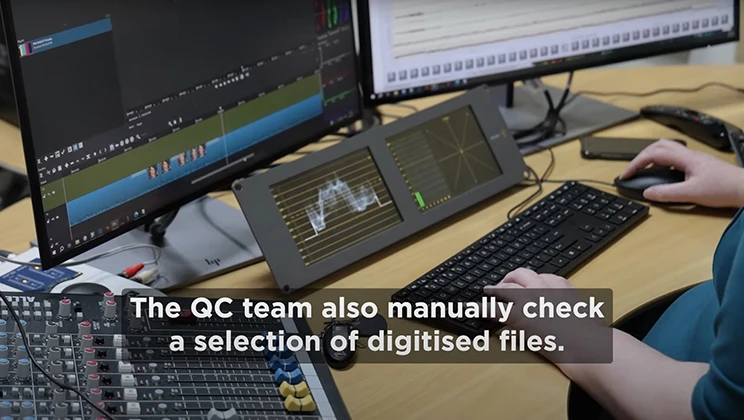
Quality control in action. Screenshot from Utaina video.
Back into storage
Once a batch of items is returned to the National Library and Archives New Zealand, our teams scan these items to track their locations in our catalogue systems, reunite them with any supporting material and reshelve them back in their respective repositories.
At this point, the digital files will also make their way into our digital preservation systems. Once ingested, the files are linked to their catalogue records and will be available to researchers.
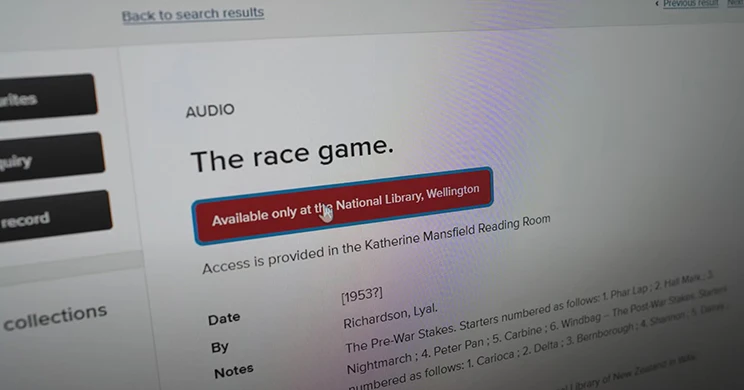
National Library website record page. Screenshot from Utaina video.
Item of interest – Race Game
The item Race Game (Phono q 4564), was interesting because of the expertise required to digitise it. It is a novelty disc with six parallel tracks on each side, as opposed to a standard record where the tracks follow on from one another. Memnon were able to digitise each track individually, creating a digital record that preserves the integrity and intention of the original item.
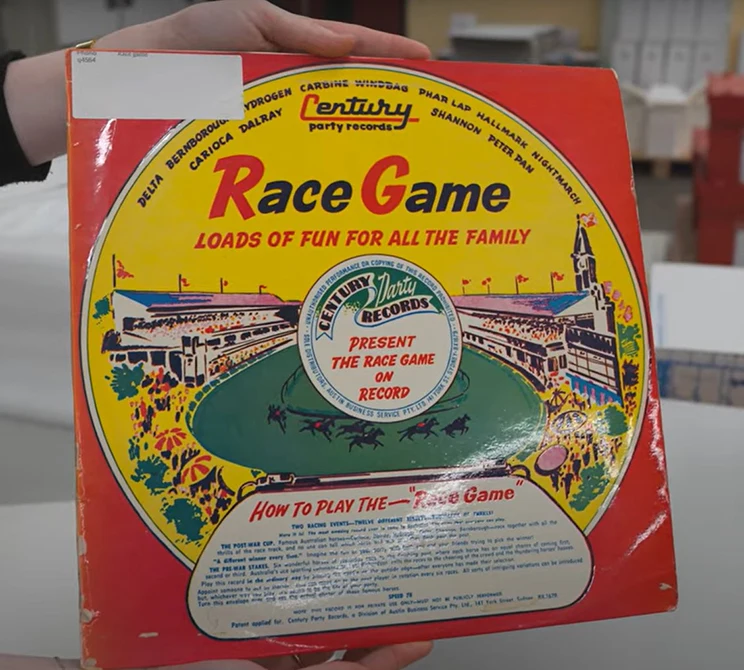
Cover of the audiovisual item Race Game. Screenshot from Utaina video.
Instructions for the game, and photographs of all the horses with their racing history, are printed on the record cover. The Race Game vinyl record was packed and transported to Memnon, digitised, quality checked, and returned to its permanent location in the National Library collection stores.
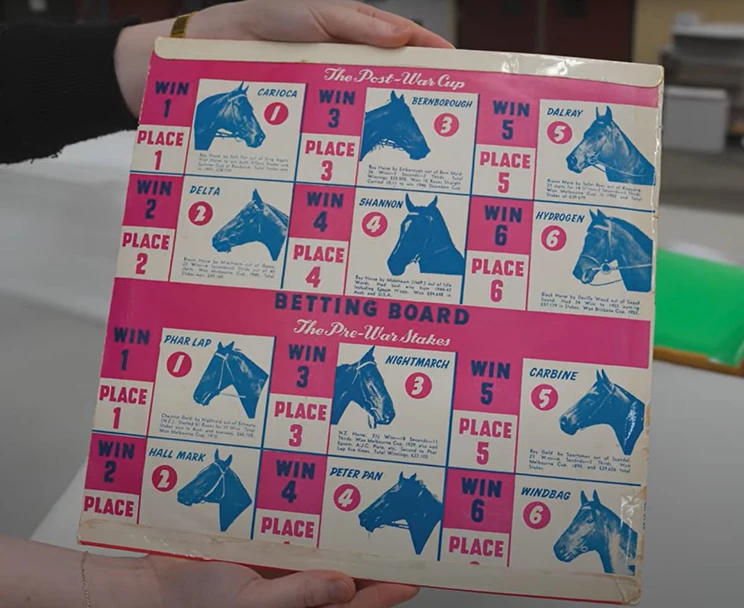
Back cover of Race Game cover. Screenshot from Utaina video.
This item was interesting because of the expertise that was required to digitise it because it is a novelty disc with six parallel tracks on each side, as opposed to a standard record where the tracks follow on from one another. Memnon were able to digitise each track individually, creating a digital record that preserves the integrity and intention of the original item.
Now the digital version of this item is preserved and available to be viewed and listened to in the Katherine Mansfield Reading Room.
What's next
Over the next two years, the Utaina project will continue to digitise the audiovisual material held by the National Library, Archives New Zealand, and Ngā Taonga Sound & Vision. As we progress with digitisation, we will update our respective catalogues so that interested researchers and the general public and access the items.
Each digitised item is another piece of Aotearoa New Zealand’s history that is preserved, capturing this heritage for New Zealand's future generations.
More about Utaina
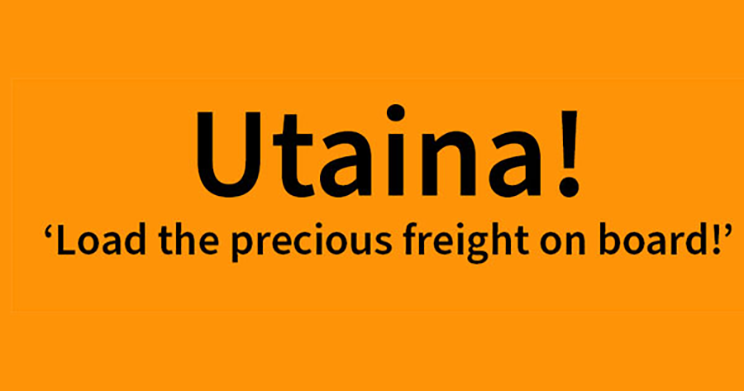
Utaina is an audiovisual digital preservation project. We're working with Archives New Zealand and Ngā Taonga Sound and Vision, to digitise audio and visual media, preserving them for future generations.